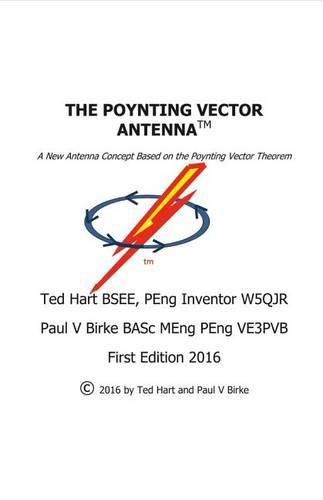The Poynting Vector Antenna
Ted Hart,Paul Birke

The Poynting Vector Antenna
Ted Hart,Paul Birke
The Poynting Theorem states that radiation is a product of the Electric (E) and Magnetic (H) fields of an antenna. The fields must occur simultaneously and have the proper curvature. This is accomplished in the Poynting antenna. A conceptual antenna has two hollow cylinders. A tuning coil resonates with the capacity between the two cylinders, thus developing a high voltage between the cylinders which creates the E field. The cylinders are very short with applied voltage on one end and open on the other. This allows RF current to flow on the cylinder which creates the H field. The two fields are in time phase and are orthogonal, thus satisfying the Poynting Theorem.
The shape of the antenna may vary from two flat plates to a Flute configuration, and virtually any shape between. The significance of the Flute is that the shape follows a cosine function allowing both fields to be active along the length of the antenna.
The Flute antenna may be tuned (simply by varying the inductance of the tuning coil) over a wide range. One of these has a total length of four (4) feet and may be tuned from 2.5 to 25 MHz with high efficiency (loss of less than 1 dB at the lowest frequency). The +/- 3 dB bandwidth is nominally one tenth (0.1) the operating frequency. Thus Q=10. The radiation pattern is isotropic and the polarization is elliptical. This virtually eliminates fading due to Faraday rotation for HF communications, and at VHF frequencies prevents nulls due to multiple reflections from large buildings.
The optimum size of the antenna is typically 3% of a wavelength, but may be less if wide bandwidth is not a design criterion. Because the radiation pattern is isotropic and radiation occurs at the antenna, two (2) or more Poynting Vector antennas may be used to form a directional array while the individual antennas are not affected by mutual coupling of the H fields.
The text of the book presents new physics concepts including a mathematical description of Radiation Resistance and suggested changes to Maxwell’s Equations. The book will be useful to every Ham operator, all Antenna Engineers, and every person concerned with Physics. Because this is a paradigm shift in antenna technology, the book is an excellent text for a graduate level antenna course.
This item is not currently in-stock. It can be ordered online and is expected to ship in approx 3 weeks
Our stock data is updated periodically, and availability may change throughout the day for in-demand items. Please call the relevant shop for the most current stock information. Prices are subject to change without notice.
Sign in or become a Readings Member to add this title to a wishlist.


